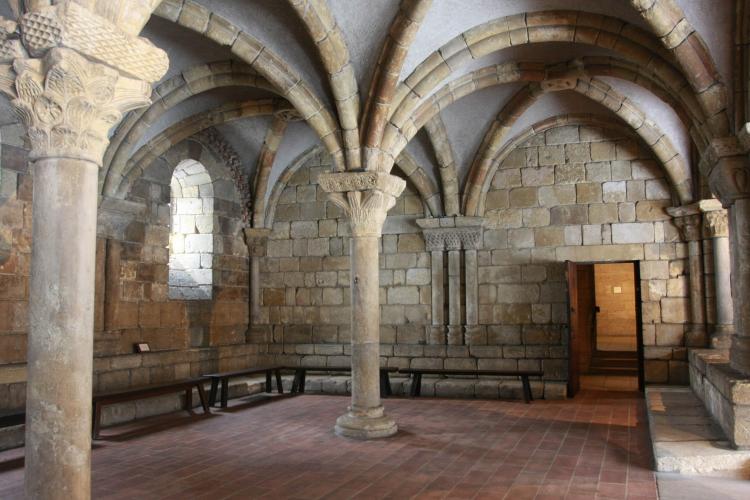NEW YORK—Far in the northern reaches of the city, nearly out of the reach of traffic and industry, of cement and steel and flashing lights—the Metropolitan Museum of Art’s Cloisters are a space apart, a solace, and a reprieve. As invigorating as the hustle and bustle of city life is, some urbanites crave a moment of stillness to recharge.
The Met’s Cloisters house the museum’s medieval collection. The Cloisters are a stone structure composed of architectural elements from the 12th to 15th centuries. Visitors step out of the 190th Street subway station and into the idyllic life of a monk or nun in the Middle Ages.
New Yorkers have long enjoyed a day at the Metropolitan Museum of Art, conveniently located so as to mingle well with an afternoon in Central Park. Sitting on a bench in the Ramble, or lounging on the Great Lawn holds its appeal, but for a true retreat within the city limits, a trip north affords a more reclusive atmosphere.
The Met’s Cloisters house the museum’s medieval collection. The Cloisters are a stone structure composed of architectural elements from the 12th to 15th centuries. Visitors step out of the 190th Street subway station and into the idyllic life of a monk or nun in the Middle Ages.
New Yorkers have long enjoyed a day at the Metropolitan Museum of Art, conveniently located so as to mingle well with an afternoon in Central Park. Sitting on a bench in the Ramble, or lounging on the Great Lawn holds its appeal, but for a true retreat within the city limits, a trip north affords a more reclusive atmosphere.
Atop a hill in Fort Tryon Park, the Cloisters rise above the din of daily life. John D. Rockefeller Jr. provided the 66.5 acres in 1927 to form the park and museum. He also donated 700 acres across the Hudson River to New Jersey to ensure the view from the hill would remain pristine.
Paths wind through the park and encircle the anachronistic structure, lined here and there with rough stone walls. Rockefeller could not stave off all signs of modern life. Visitors are reminded that it is still the 21st century by the rushing sounds of automobiles on the West Side Highway below that drift upward and by the factories and modern dwellings in the expanse beyond the rocky walls.
Paths wind through the park and encircle the anachronistic structure, lined here and there with rough stone walls. Rockefeller could not stave off all signs of modern life. Visitors are reminded that it is still the 21st century by the rushing sounds of automobiles on the West Side Highway below that drift upward and by the factories and modern dwellings in the expanse beyond the rocky walls.
All the same, these reminders of modern life provide a juxtaposition that highlights the beauty of the past. The timeless flowing of the Hudson River, at least, suits the scene perfectly.
Within, the atmosphere is one of harmony created by a symmetrical design. The arched doorways, stained-glass windows, pillars, and courtyards all convey a sense of balance and graceful purity.
The cloister is the heart of a monastery. It is a covered passageway that surrounds a courtyard. It served as a place for meditation or reading aloud. It also was where the monks would wash their clothes and bathe themselves. All of the monastery’s buildings would connect via this passageway, so it was a place of meeting as well as quiet contemplation.
Within, the atmosphere is one of harmony created by a symmetrical design. The arched doorways, stained-glass windows, pillars, and courtyards all convey a sense of balance and graceful purity.
The cloister is the heart of a monastery. It is a covered passageway that surrounds a courtyard. It served as a place for meditation or reading aloud. It also was where the monks would wash their clothes and bathe themselves. All of the monastery’s buildings would connect via this passageway, so it was a place of meeting as well as quiet contemplation.
Large, wooden doors stand open to the connecting chambers—a warm, soft light glowing from the entrance way invites one to enter through them. Natural light streaks the stone floor through raised windows. The heart of the cloister is a courtyard wide open to the sun’s shining rays, though now ensconced in glass until the weather warms.
The medieval garden was rife with symbolic meaning as well as practical uses. The hortus conclusus, or “garden enclosed,” is associated with the “virgin Mary” (mother of Jesus), and she is often depicted there. The violets that grow in the cloister’s garden are also associated with the virgin. They grow low, and are thus equated with Mary’s humility. In a medieval manual for herbal medicine, Hildegard of Bingen provides a recipe for oil of violets to cure blurred vision.
Much more than a venue of medieval art, the Cloisters are a portal to a kind of life both medieval and peaceful.
The medieval garden was rife with symbolic meaning as well as practical uses. The hortus conclusus, or “garden enclosed,” is associated with the “virgin Mary” (mother of Jesus), and she is often depicted there. The violets that grow in the cloister’s garden are also associated with the virgin. They grow low, and are thus equated with Mary’s humility. In a medieval manual for herbal medicine, Hildegard of Bingen provides a recipe for oil of violets to cure blurred vision.
Much more than a venue of medieval art, the Cloisters are a portal to a kind of life both medieval and peaceful.












